August’s Fungi Focus: The Collared Parachute (Marasmius rotula)

There are quite a few conspicuous Summer fungi that you might have seen popping up recently. One of the most commonly found and easy to identify is the subject of this month’s focus, the Collared Parachute (Marasmius rotula) referred to alternatively by the names of the Pinwheel Mushroom or the Horse Hair fungus. These alternate names present fairly accurate descriptions of the characteristic appearance of this dainty looking but tough mushroom, which you’ll find growing in groups in the leaf litter from the first June rains through to November. The thin and fibrous stem that is the same ivory white colour at the top as the tough, dry pleated cap that it supports but darkens from russet brown to near black towards its base is one feature that it shares with a number of other species in the Marasmius genus. More distinctive is the collar, or collarium to give it its technical name, that separates the gills from the stem, with the gills themselves fairly widely spaced and running outwards to the cap edges.
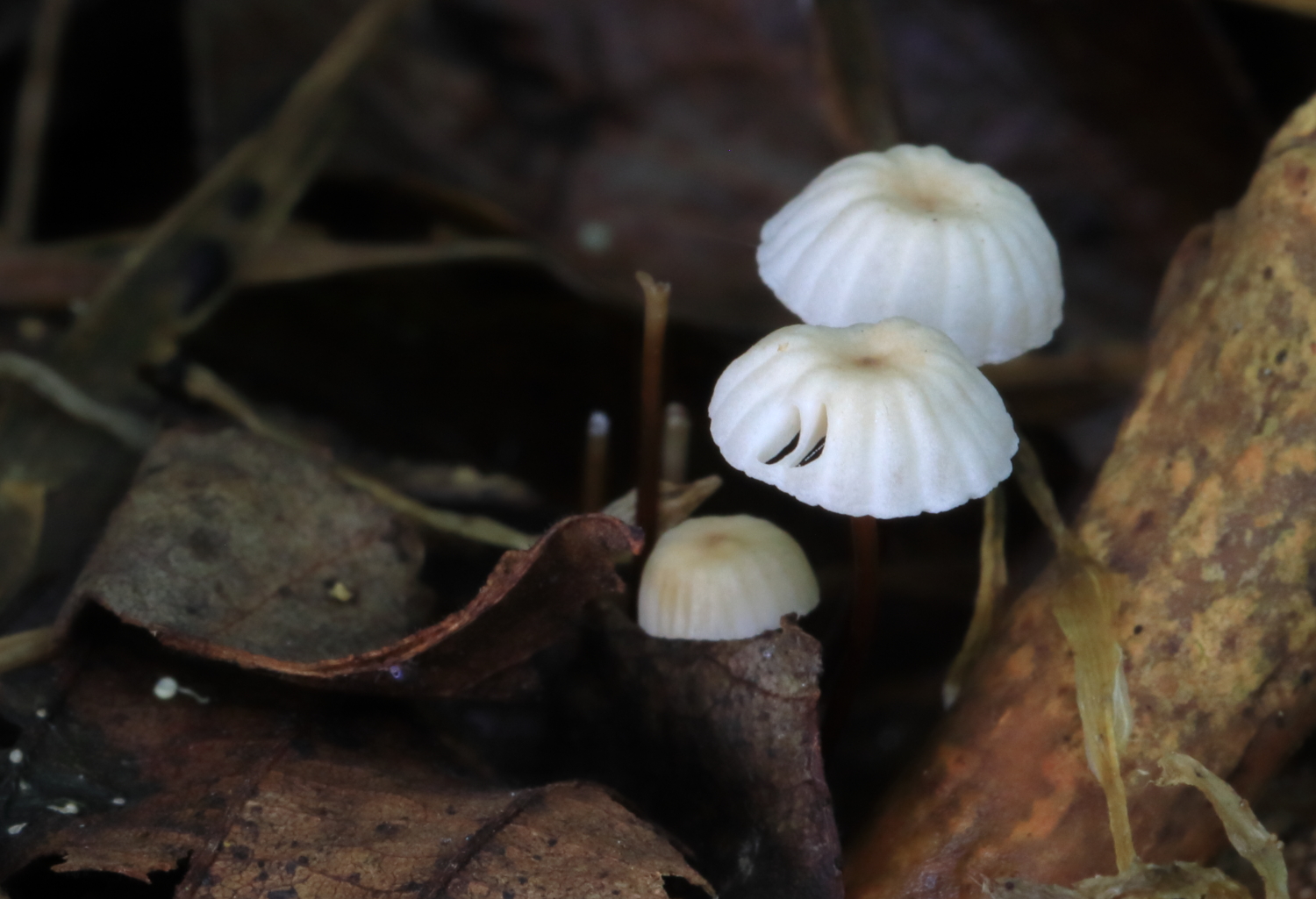
The ivory white pleated cap of the Common Parachute with its umbilicate depression in the centre
The Collared Parachute is not the only Marasmius with a collarium, but it can be distinguished from its closest lookalikes by a number of other features without having to resort to a microscope. Marasmius bulliardii, the species with which it is most likely to be confused with, is slightly smaller, its cap reaching a maximum of 1cm in diameter against the 1-1.5cm of the Collared Parachute, but is also more brownish in colour and darkens considerably more in the umbilicate depression at the top of the cap, forming what Laessoe and Peterson in Fungi of Temperate Europe describe as an ‘eye spot’. They also mention that the stem has a tendency too to produce side branches. Despite not having encountered this species myself, this certainly seems enough to differentiate it clearly. The authors also mention a Marasmius wettsteinii, which only grows on fallen needle debris, but the other key identification feature for the Collared Parachute is that unlike these two latter species, it doesn’t grow on the leaf litter itself, but on small twigs buried within it or, for example, in lawns or other grasslands. (Michael Kuo of MushroomExpert.com draws attention to a number of North American lookalikes).
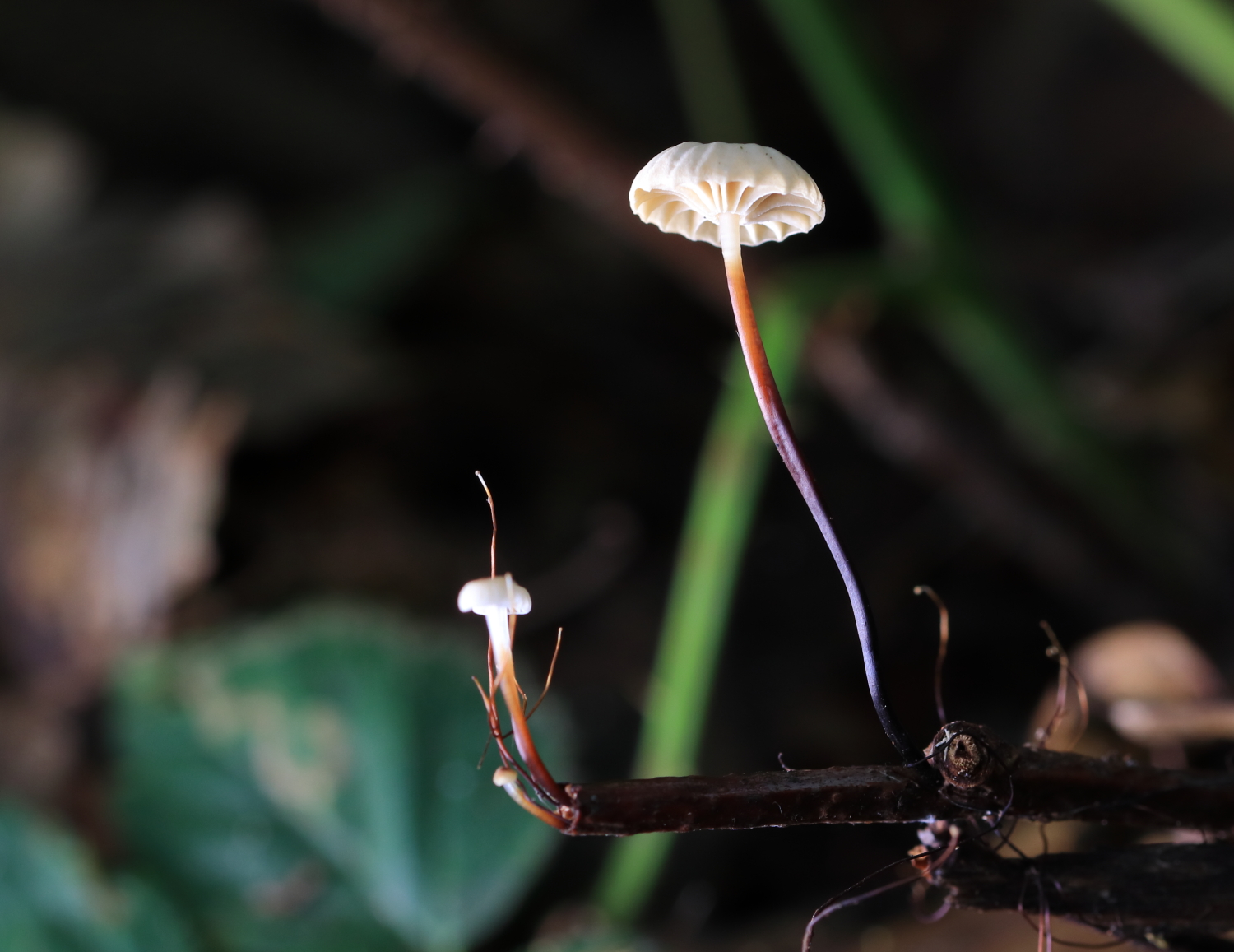
A key means of differentiating the Collared Parachute from similar collared species is that is grows on twigs rather than leaf litter
The Collared Parachute gives us a good opportunity to reflect upon why the various features that we use to distinguish certain mushroom types might have evolved, a subject that is investigated in a rather fascinating article I have encountered entitled ‘Tales and mysteries of fungal fruiting: How morphological and physiological traits affect a pileate lifestyle’ by Hans Halbwachs, Josef Simmel and Claus Bässler published in the June 2016 issue of Fungal Biology Reviews, which I shall summarise here but can be found in its entirety online here .
The authors’ focus is primarily on “basidiomycete macrofungi that form mushrooms, i.e. agaricoid and boletoid fruit bodies of saprotrophic and ectomycorrhizal fungi” – that is basically fungi that form mushroom shaped fruiting bodies with either gills or pores rather than the brackets, jellies, and crusts that I have covered in some of my previous posts. They explore how certain traits, like shape, size, colour, texture, taste and smell, as well as longevity and other growing habits, might have evolved to fit the various environmental niches specific species might inhabit.
Mushrooms, as has been mentioned in several of these fungi focus posts, are only the temporarily appearing reproductive organs of an organism whose essential “body” or substance is the network of mycelium that exists largely unseen growing within and feeding upon its chosen substrate. Their primary purpose is to produce and disperse spores, which can happen either by elemental conditions like wind and water carrying them afar, or animal vectors like insects, mammals, birds or whatever that can transport them many kilometres either on their bodies or sometimes in their digestive systems. That said, presumably a lot of spores don’t survive the process of being consumed, so mushrooms also need to be able to protect the spores that develop within them.
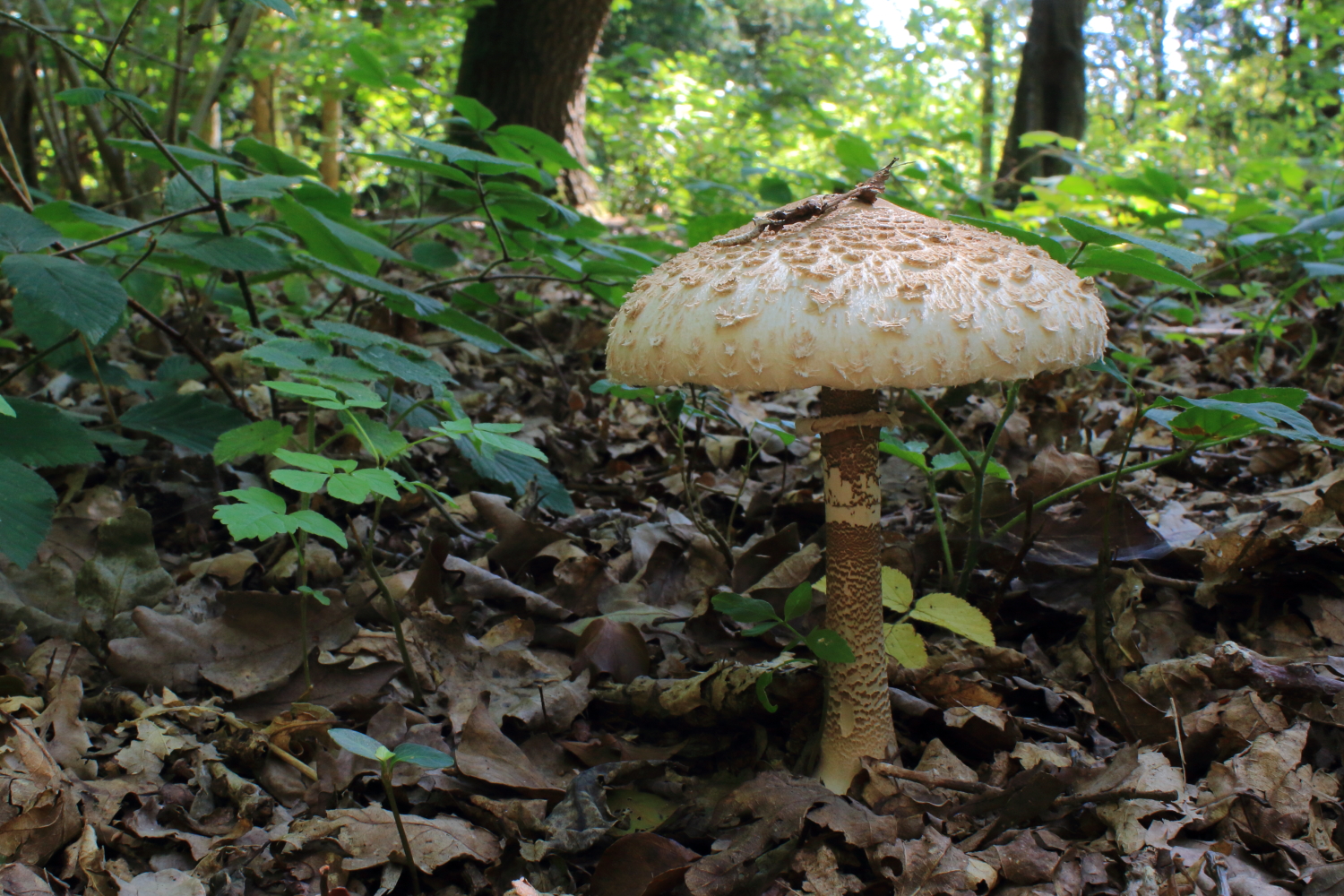
The Shaggy Parasol (Chlorophyllum rhacodes) possesses a long stalk and wide cap optimising it for spore production and dispersal, with a ring around its snakeskin stipe and floccose upperside to deter predators from getting to its gills.
As the writers point out, this is a surprisingly under-researched topic, due to the transient nature of so many mushroom fruiting bodies and the difficulties in reproducing in controlled laboratory conditions the complex processes that go on in the natural environment. Nevertheless, we have to assume that there are fundamental reasons between the huge variations in different types of mushroom fruiting bodies. Compare, for example, the large and robust saucer shapes of the Parasol and Shaggy Parasol mushrooms with the minute and short-lived mycena, like the Frosty Bonnet.
One key observation is that larger fruiting bodies survive to produce spores over a much longer period of time. The given example is the Clouded Funnel (Clitocybe nebularis) , whose fruit bodies can last for up to 30 days. The tiny Pleated Inkcap (Parasola plicatilis), in contrast, comes and goes within a matter of hours. The hypothesis is that the larger bodies retain moisture for longer and thereby avoid drying out, while the greater proportion of the fleshier parts of the cap (called the trama) might possibly delay destruction of the spore-producing gills by those creatures that might consume these more substantial parts of the mushroom rather than the gills themselves.
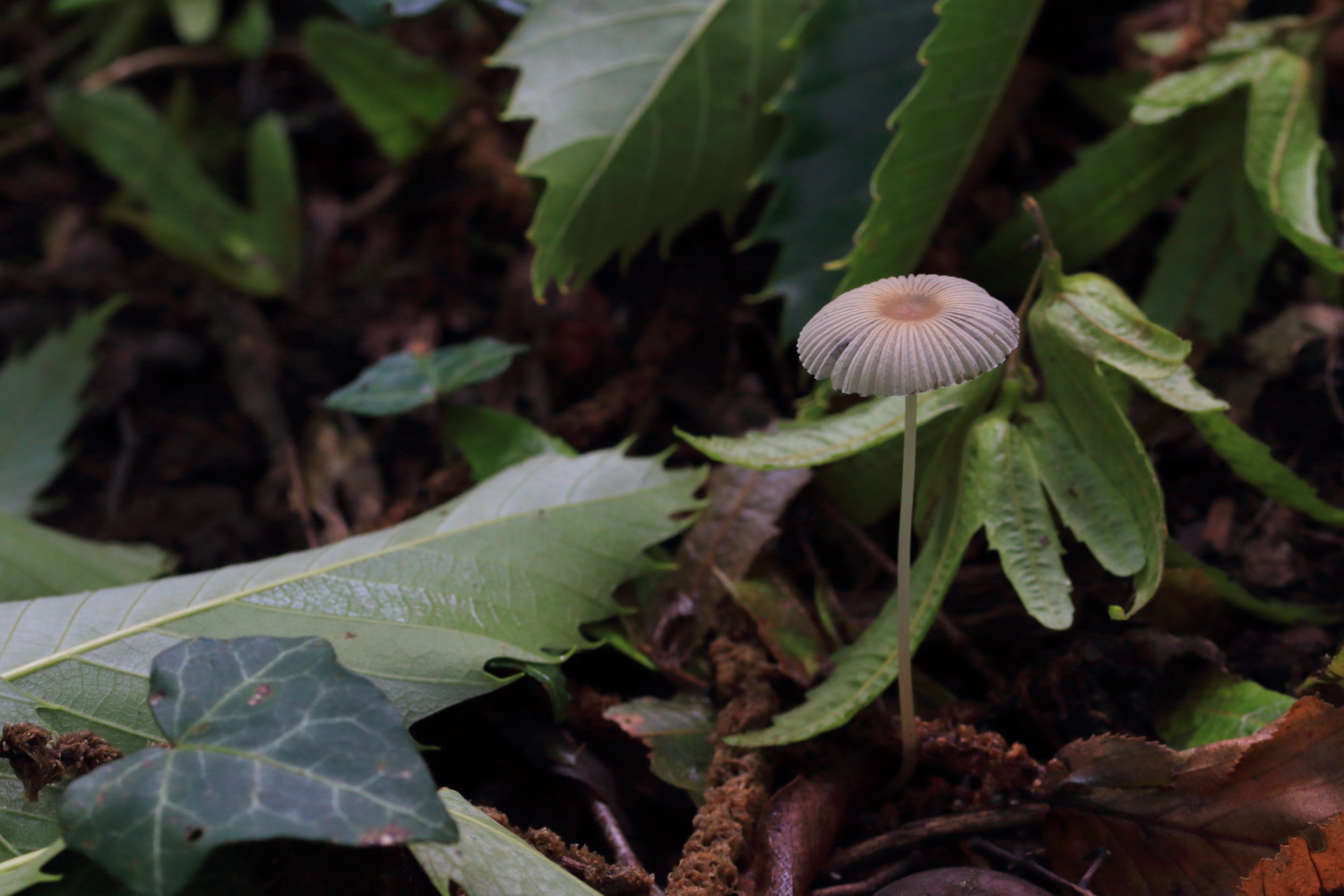
The Pleated Inkcap (Parasola plicatilis), one of the many tiny saprotrophic mushrooms that appear and vanish within a matter of hours
We can see in this that the cap (or pileus) provides a number of functions. The upper skin cuticle known as the pileipellis that covers the fleshy tissue of the trama, which in some cases can be peeled from the mushroom, simultaneously might protect the mushroom from desiccation, excessive moisture or other things related to temperature variations in general as well as predators coming at it from above. Apparently our common cultivated supermarket button mushroom, Agaricus bisporus, possesses a hydrophobic pileipellis that prevents the flesh from getting waterlogged in wet conditions.
The pigmentations that account for the different colourings of, for example, the numerous Brittlegills or Russula species might be to create tastes that may deter certain creatures from eating through to the trama, as well as having antibiotic functions to arrest decomposition from bacteria or other secondary fungi.
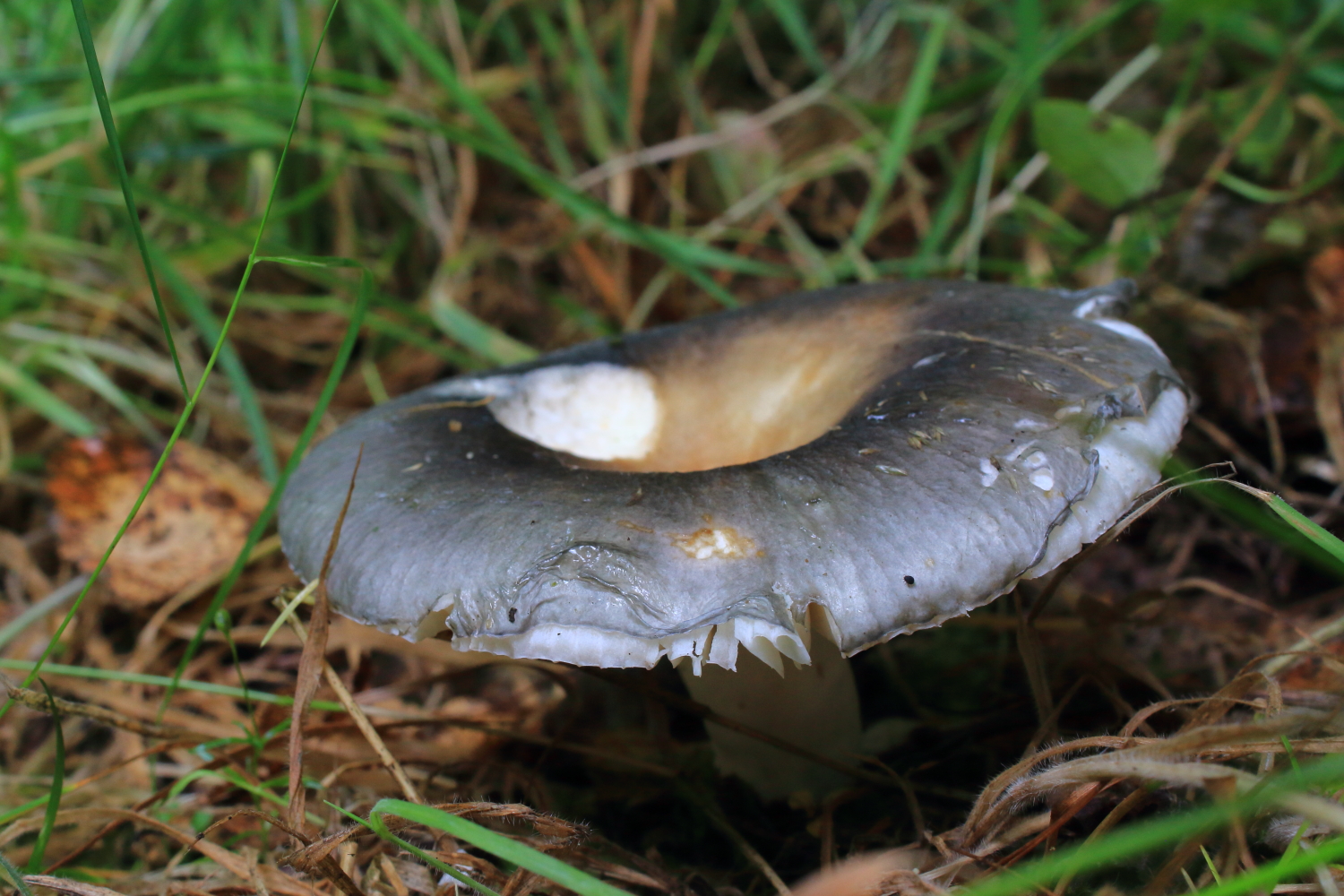
The peeling grey-green pileipellis covering the trama of this Powdery Brittlegill (Russula parazurea) offers protection from the elements and certain predators.
In various species, the cap’s upper surface might be floccose, viscid, spiny, hairy, or even covered in small crystals, like the Mica Inkcap : in each case providing a payoff as to whether to attract or deter insects or avoid desiccation or waterlogging.
The trama itself supports the gills (or pore tubes in the case of boletes), providing the means to space them apart and orient them vertically, so that this spore-producing surface (or hymenium) faces downwards, allowing gravity to facilitate the spores downwards drop: gill spacing is another variable that confers benefits to different species in different ways, and one again notes how comparatively distant the gills are in the thin-fleshed Collared Parachute compared with much larger species such as the much meatier Parasol Mushroom mentioned above. Smaller and fewer gills means it lacks the capacity to produce as many spores as quickly.
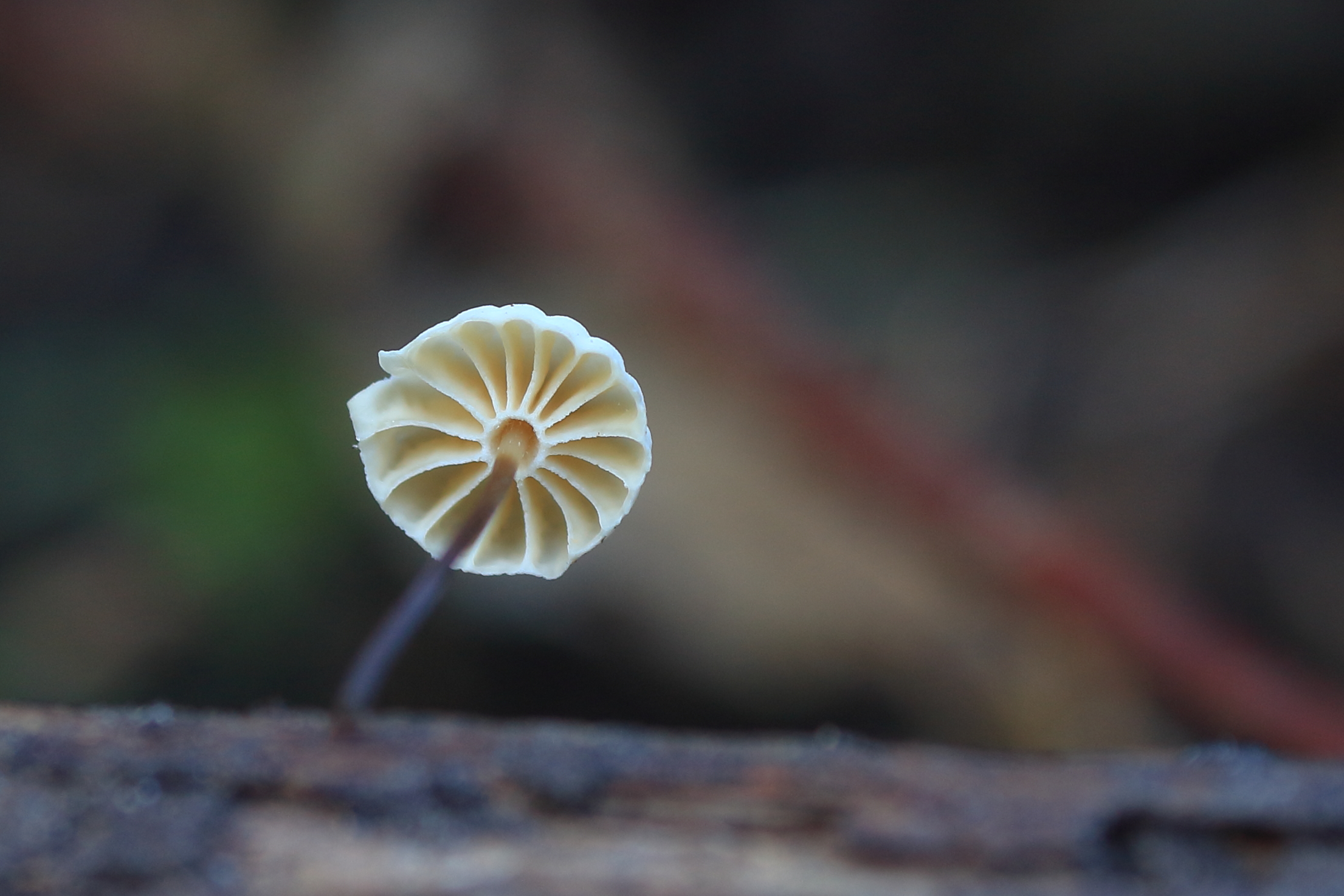
The distinctive underside of the Collared Parachute reveals widely-spaced gills that are separated from the stipe by a collarium and supported by an exceedingly insubstantial trama
The cap and stem also serve as bait for animal vectors, either to lure them away from the spore producing gills or pores, or maybe towards them, so they might attract inadvertently carry the spores further away. One does notice, for example, the incredibly thick fleshed boletes are often riddled with maggots and worms long before we might get them anywhere near a frying pan.
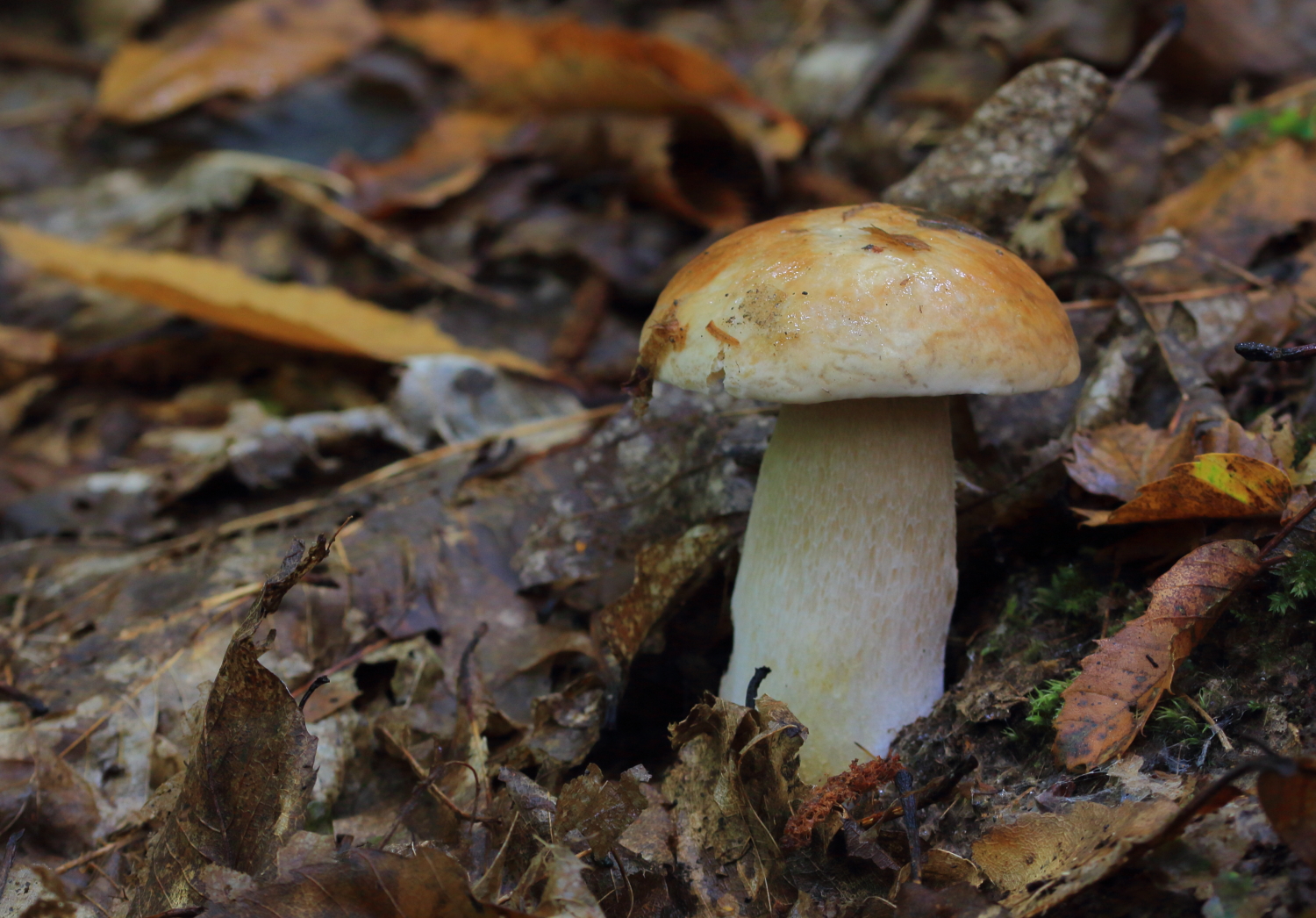
The thick meaty stem and cap of ectomycorrhizal boletes like the Penny Bun (Boletus edulis) might perform a number of functions
So that really just leaves the stem, or stipe, whose purpose is to support the cap above the substrate surface and transport nutrients to it. The higher the cap above the ground, the more efficient spore dispersal is through the wind. Different species again have different methods or varying efficiency for deterring insects or slugs from crawling up on the outside to get to the gills. The stem ring we see on the Parasol and many of the Amanitas serve as one such impediment from ground-level attack.
The hair-like stem of tiny types like the Collared Parachute clearly won’t support the weight of sizeable predators like slugs, nor does it afford much of a channel for the regular transport of nutrients to the cap. The fungi itself has evidently invested less of its resources into growing its fruitbody than with the massive thick stiped boletus, which the article’s authors hypothesise might act “as nutrient and water repository, possibly a biomass investment into longevity”.
The stem coloration is interesting though, as the authors argue that the varying pigmentation of different species might be due to anti-microbial chemical compounds developed by the fungi – the darker area towards the base of the Collared Parachute might stop small bacteria or other fungi from decaying this thin stem, or smaller insects from crawling up it. Equally, the collarium must similarly serve the purpose of obstructing the smaller critters from getting access to the gills once they’ve reached the top of the stipe, and let’s face it, there’s precious little meat on Marasmius rotula for would be predators anywhere else. It goes without saying it is considered ‘inedible’ as far as human consumption goes.
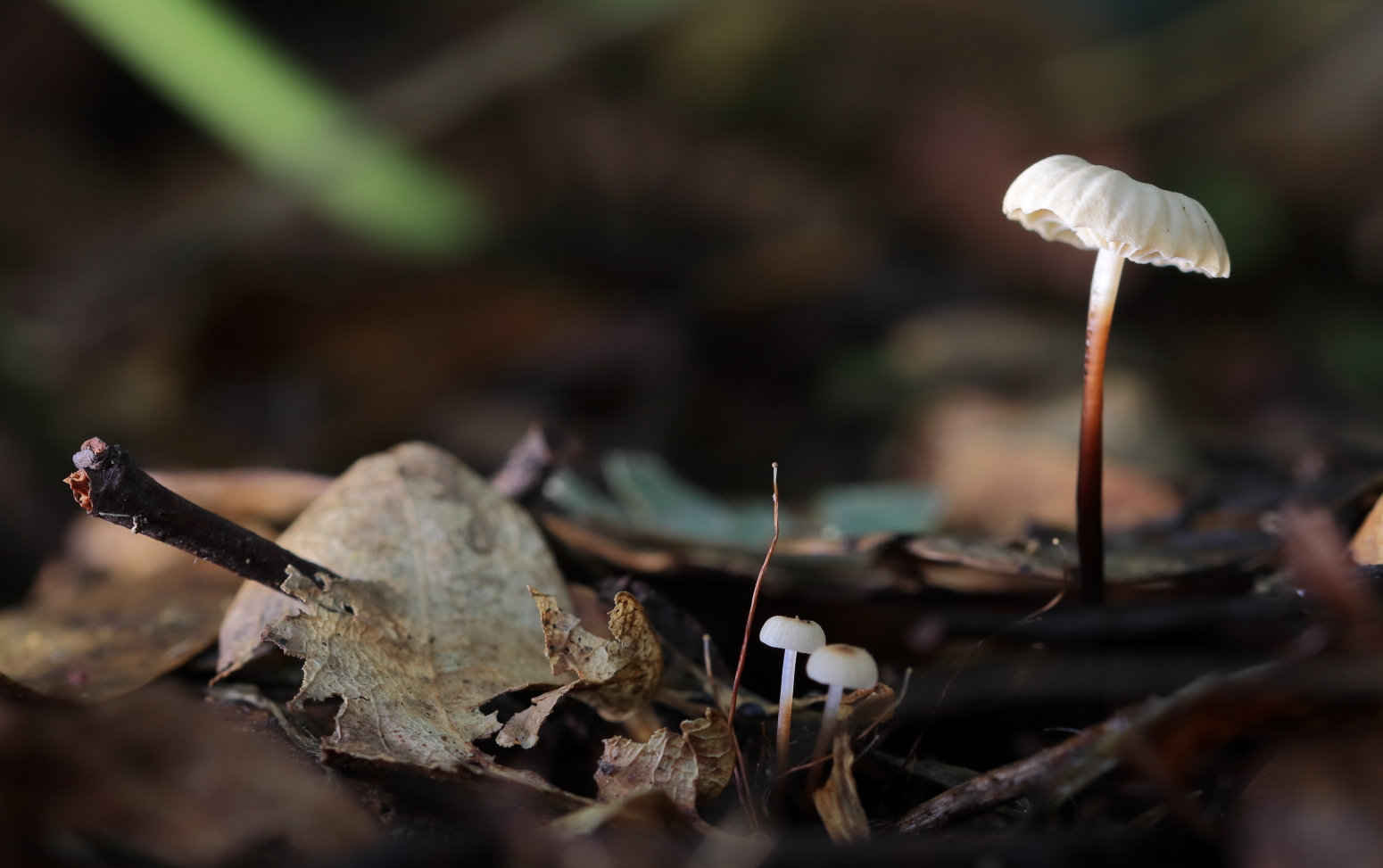
The thin fibrous stem of the Collared Parachute darkens towards its base while the cap has an angular, slightly squarish aspect when viewed from the side
We can go into much more detail about other aspects such as cap shape, chemical composition and toxicity, but in all these cases, there is a payoff involved in optimising spore dispersal depending on the environment. One general observation that the authors make is that those species that only exist in the upper levels of the soil profile - for example, the saprophytic species that continue the breakdown process of decaying organic matter such as leaf litter - tend to produce a lot more numerous and smaller fruit bodies that individually last a far shorter time.
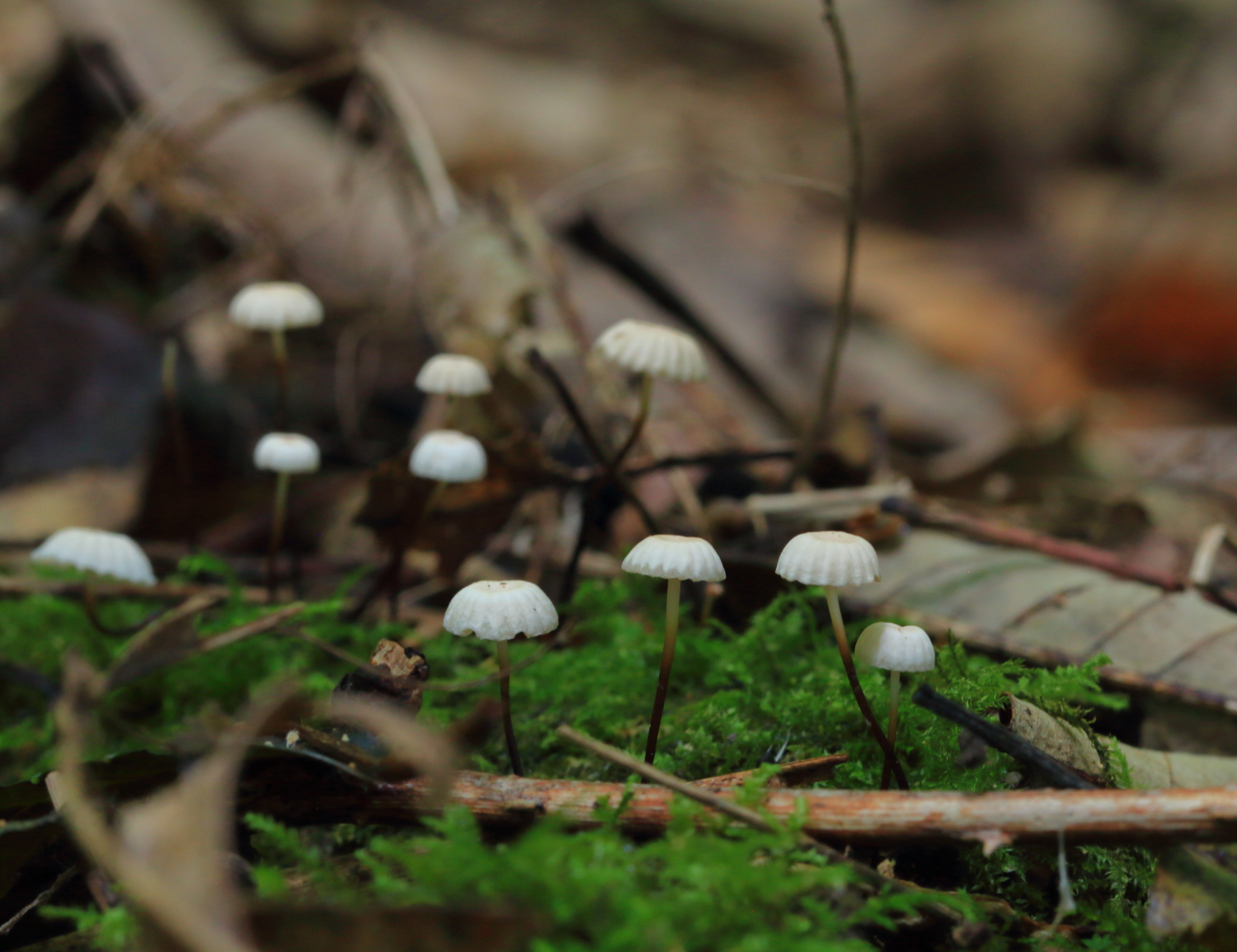
Collared Parachutes grow in troops on twigs buried in the litter layer of woodlands
This is fairly evident when we consider the larger sizes and relative longevity of the endomycorrhizal Amanitas , boletes or russulas whose mycelium extends down into the depths of the forest soil by associating with their host tree’s roots in comparison with the smaller species like the mycena that grow on shallow leaf litter, which is prone to all sorts of disturbance, either by heavy rains or by drying out in the summer months or by being kicked about by passing creatures.
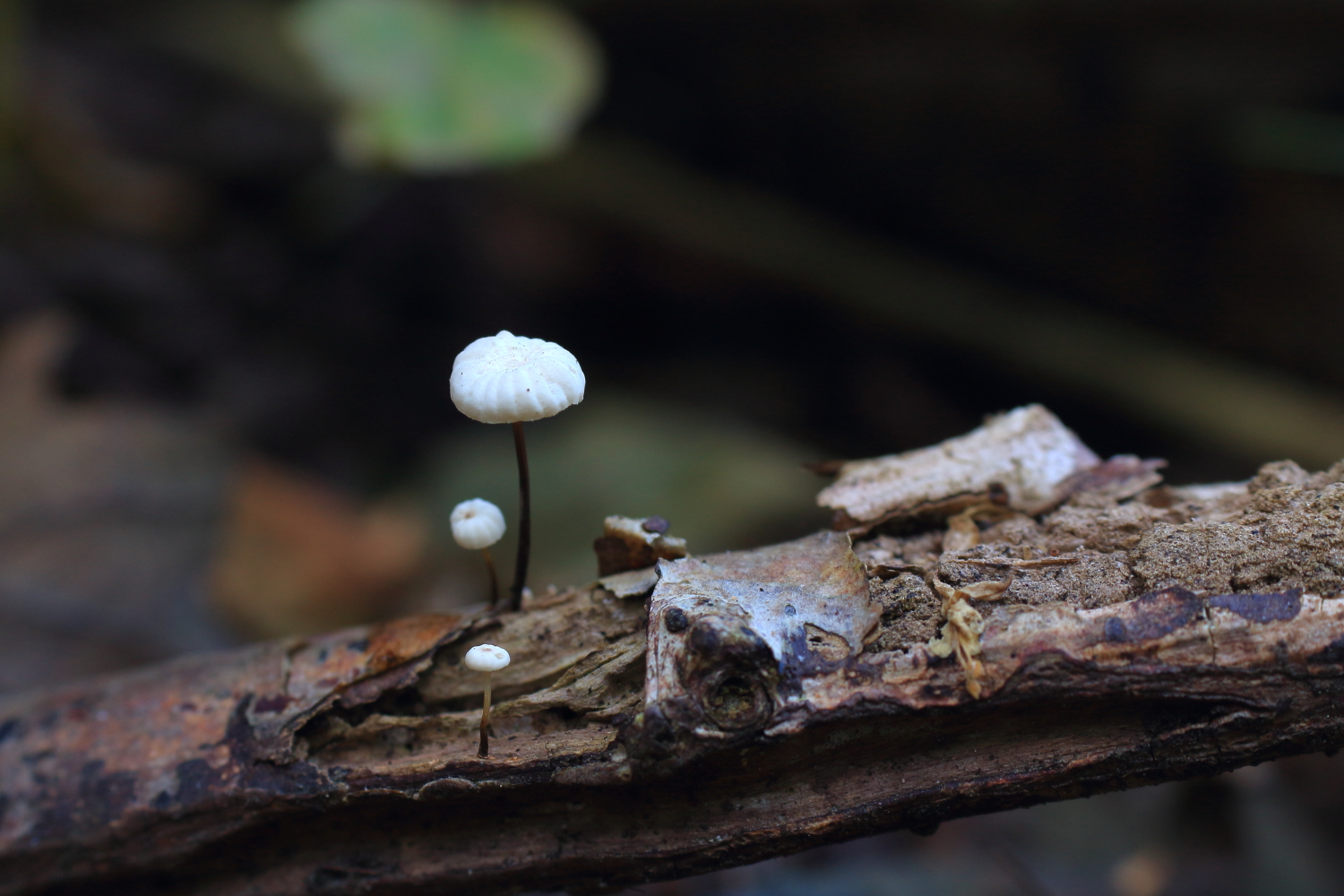
The extent of the mycelium growth of the Collared Parachute (Marasmius rotula) is presumably limited by the size of its substrate.
The small size of the Collared Parachute mushrooms might lead one to assume that its fruitbodies are equally ephemeral and prone to rapid decay or evanescence: after all, the actual fungi as a whole, its resources restricted by the relatively small size of the twigs that serve as its host, surely can’t boast much in the way of an extensive mycelial network unlike, say, a Honey Fungus of a Fly Agaric.
However, this seems not in fact to be the case. Laessoe and Peterson describe the whole of the Marasmius genus as “tough, drought-tolerant fungi”, while the authors of the “Tales and mysteries of fungal fruiting” paper describe how the Collared Parachute belongs to one of the few groups “that have evolved a trick to overcome the dispersal constraints connected with small fruit bodies, i.e. sensitivity to desiccation. Marasmius rotula can survive through rewetting several weeks.”
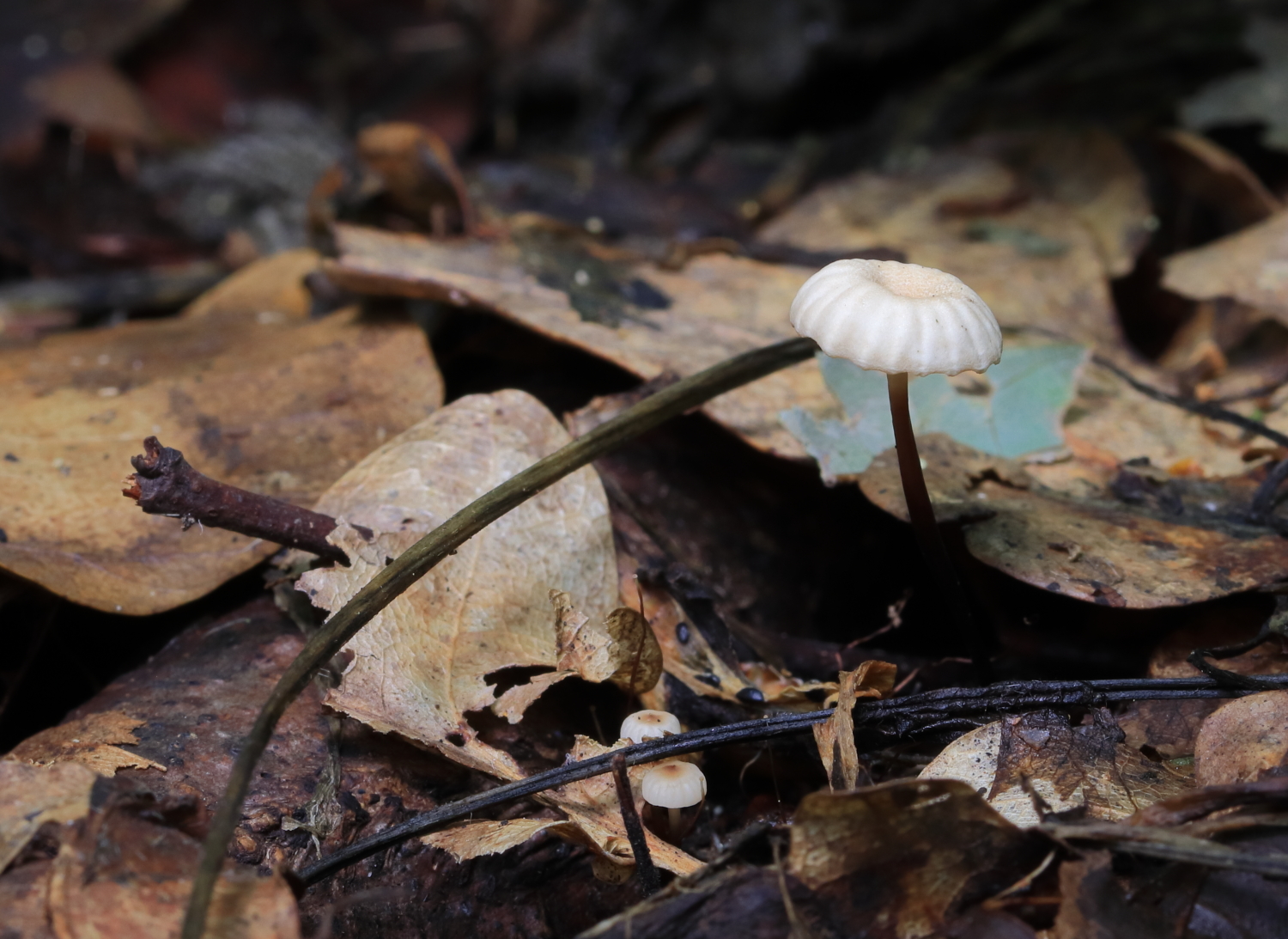
The small but robust Collared Parachute is a common site in British woodlands over the Summer months
One final interesting observation about the Collared Parachute is that, unlike other mushrooms that release their spores in accordance with the circadian rhythms of their internal fruitbody clocks, spore release in this species is dependent on moisture levels, and an individual fruitbody might continue to dry out and rehydrate to release their spores for a total of up to three weeks.
Hence the reason for making this particular species the subject of August’s fungi focus. Once these resilient little fruit bodies have emerged, they may dry out during hot and dry periods, but a brief downpour will see them popping up again revivified, making them one of the more commonly encountered mushrooms of the climatically unpredictable British summer months.
Comments are closed for this post.

As usual, a fascinating read.
Thank you.
Chris Saunders
12 August, 2020